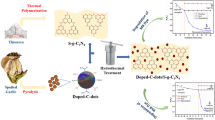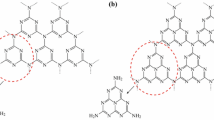Abstract
The visible-light-responsive composite photocatalyst is beneficial to improve the solar energy utilization efficiency through the coupling of narrow bandgap materials. In this work, CdS nanowires were prepared by hydrothermal method, and then BiOBr/CdS composite materials with different mass ratios were successfully prepared by a simple two-step sonography-precipitation method using CdS nanowires as a deposition template. The photocatalysts were characterized by XRD, SEM, XPS, TEM, and other methods. Rhodamine B (RhB) was used as a model pollutant to evaluate the photocatalytic activity of BiOBr/CdS catalysts with different mass ratios. The photocatalytic test results show that the composite photocatalyst containing 60% BiOBr has the highest photocatalytic activity, which indicates that it is related to the decrease in photogenerated charge recombination rate. Subsequently, the electrochemical and physical methods were used to illustrate the electron transfer mechanism and the main active center of the as-prepared samples. Free radical capture experiments reveal that holes are the main active species in the photocatalytic process of composite samples.
Graphical abstract
BiOBr/CdS composite photocatalyst was prepared by a simple precipitation method using dispersed one-dimensional CdS nanowires as a template. BiOBr/CdS heterostructure combined adsorption and catalysis to degrade RhB molecules more efficiently. Free radical trapping experiments reveal that holes are the main active species in the photocatalytic process of composite samples.






Similar content being viewed by others
References
Guo R, He Y, Yu T et al (2020) Enhanced oxygen evolution reaction activity of flower-like FeOOH via the synergistic effect of sulfur. Chem Eng J 127587:8
Li F, Lu C, Xu B, Cheng LY (2020) Photocatalytic degradation of rhodamine B under visible light irradiation by TiO2 doped layered zirconium phosphates. J Nanosci Nanotechno 20:1697–1703
Yao CH, Wang XJ, Zhao W et al (2020) Probing the facet-dependent intermediate in the visible-light degradation of RhB by carbon-coated anatase TiO2 nanoparticles. J Alloys Compd 846(156335):9
Yu HB, Huang BB, Wang H et al (2018) Facile construction of novel direct solid-state Z-scheme AgI/BiOBr photocatalysts for highly effective removal of ciprofloxacin under visible light exposure: mineralization efficiency and mechanisms. J Colloid Interf Sci 522:82–94
Zhang JF, Lv JL, Dai K et al (2018) One-step growth of nanosheet-assembled BiOCl/BiOBr microspheres for highly efficient visible photocatalytic performance. Appl Surf Sci 430:639–646
Alansi AM, Al-Qunaibit M, Alade IO et al (2018) Visible-light responsive BiOBr nanoparticles loaded on reduced graphene oxide for photocatalytic degradation of dye. J Mol Liq 253:297–304
Sin JC, Lim CA, Lam SM et al (2019) Facile synthesis of novel ZnO/Nd-doped BiOBr composites with boosted visible light photocatalytic degradation of phenol. Mater Lett 248:20–23
Liu XW, Ni ZY, He Y et al (2019) Ultrasound-assisted two-step water-bath synthesis of g-C3N4/BiOBr composites: visible light-driven photocatalysis, sterilization, and reaction mechanism. New J Chem 43:8711–8721
Hu M, Yan AH, Wang XY et al (2019) Hydrothermal method to prepare Ce-doped BiOBr nanoplates with enhanced carrier transfer and photocatalytic activity. Mater Res Bull 116:89–97
Allagui L, Chouchene B, Gries T et al (2019) Core/shell rGO/BiOBr particles with visible photocatalytic activity towards water pollutants. Appl Surf Sci 490:580–591
Jiang M, Shi YB, Huang JW et al (2018) Synthesis of flowerlike g-C3N4/BiOBr with enhanced visible light photocatalytic activity for dye degradation. Eur J Inorg Chem 17:1834–1841
Palmai M, Zahran EM, Angaramo S et al (2017) Pd-decorated m-BiVO4/BiOBr ternary composite with dual heterojunction for enhanced photocatalytic activity. J Mater Chem A 5:529–534
Li Y, Chen SB, Zhang KJ et al (2020) Highly efficient and stable photocatalytic properties of CdS/FeS nanocomposites. New J Chem 44:14695–14702
Rajbongshi H, Kalita D (2020) Morphology-dependent photocatalytic degradation of organic pollutant and antibacterial activity with CdS nanostructures. J Nanosci Nanotechno 20:5885–5895
Guo R, Yan AG, Xu JJ et al (2019) Effects of morphology on the visible-light-driven photocatalytic and bactericidal properties of BiVO4/CdS heterojunctions: a discussion on photocatalysis mechanism. J Alloys Compd 817(153246):12
Cui HJ, Zhou YW, Li ZY et al (2018) Synthesis of CdS/BiOBr nanosheets composites with efficient visible-light photocatalytic activity. J Phys Chem Solids 112:80–87
Tonda S, Kumar S, Gawli Y et al (2017) g-C3N4 (2D)/CdS(1D)/rGO(2D) dual-interface nano-composite for excellent and stable visible light photocatalytic hydrogen generation. Int J Hydrog Energy 42:5971–5984
Gao MC, Zhang DF, Pu XP et al (2015) BiOBr photocatalysts with tunable exposing proportion of 001 facets: combustion synthesis, characterization, and high visible-light photocatalytic properties. Mater Lett 140:31–34
Xu F, Yuan YF, Han HJ et al (2012) Synthesis of ZnO/CdS hierarchical heterostructure with enhanced photocatalytic efficiency under nature sunlight. CrystEngComm 14:3615–3622
Liu XQ, Cai L (2019) A novel double Z-scheme BiOBr-GO-polyaniline photocatalyst: Study on the excellent photocatalytic performance and photocatalytic mechanism. Appl Surf Sci 483:875–887
Li LL, Yin XL, Sun YQ (2019) Facile synthesized low-cost MoS2/CdS nanodots-on-nanorods heterostructures for highly efficient pollution degradation under visible-light irradiation. Sep Purif Technol 212:135–141
Fan QZ, Chen X, Chen FY et al (2019) Regulating the stability and bandgap structure of BiOBr during thermo-transformation via La doping. Appl Surf Sci 481:564–575
Chava RK, Do JY, Kang M (2018) Smart hybridization of Au coupled CdS nanorods with few layered MoS2 nanosheets for high performance photocatalytic hydrogen evolution reaction. ACS Sustain Chemi Eng 6:6445–6457
Tang L, Lv ZQ, Xue YC et al (2019) MIL-53(Fe) incorporated in the lamellar BiOBr: promoting the visible-light catalytic capability on the degradation of rhodamine B and carbamazepine. Chem Eng J 374:975–982
Zhang MM, Lai C, Li BS et al (2019) Rational design 2D/2D BiOBr/CDs/g-C3N4 Z-scheme heterojunction photocatalyst with carbon dots as solid-state electron mediators for enhanced visible and NIR photocatalytic activity: kinetics, intermediates, and mechanism insight. J Catal 369:469–481
Chen JY, Xiao XY, Wang Y et al (2019) Novel AgI/BiOBr/reduced graphene oxide Z-scheme photocatalytic system for efficient degradation of tetracycline. J Alloys Compd 800:88–98
Wei ZP, Dong XL, Zheng N et al (2020) Novel visible-light irradiation niobium-doped BiOBr microspheres with enhanced photocatalytic performance. J Mater Sci 55:16522–16532. https://doi.org/10.1007/s10853-020-05265-3
Zhou M, Huang WM, Zhao YP et al (2020) 2D g-C3N4/BiOBr heterojunctions with enhanced visible light photocatalytic activity. J Nanopart Res 22(13):11
Liu SB, Chen JX, Liu DY et al (2019) Improved visible light photocatalytic performance through an in situ composition-transforming synthesis of BiVO4/BiOBr photocatalyst. J Nanopart Res 21(191):10
Zhang WJ, Fu J, Wang Y et al (2019) Enhanced visible-light photocatalytic activity of ZnS/BiOBr/graphene oxide ternary composite. J Phys Chem Solids 127:19–27
Wang HT, Shi MS, Yang HF et al (2018) Template-free synthesis of nanosliced BiOBr hollow microspheres with high surface area and efficient photocatalytic activity. Mater Lett 222:164–167
Herrmann JM (1995) Heterogeneous photocatalysis: an emerging discipline involving multiphase systems. Catal Today 24:157–164
Yang Y, Zhang Y, Fang ZB et al (2017) Simultaneous realization of enhanced photoactivity and promoted photostability by multilayered MoS2 coating on CdS nanowire structure via compact coating methodology. ACS Appl Mater Interfaces 9:6950–6958
Bao SY, Wu QF, Chang SZ et al (2017) Z-scheme CdS-Au-BiVO4 with enhanced photocatalytic activity for organic contaminant decomposition. Catal Sci Technol 7:124–132
Xu Y, Fu ZC, Cao S et al (2017) Highly selective oxidation of sulfides on a CdS/C3N4 catalyst with dioxygen under visible-light irradiation. Catal Sci Technol 7:587–595
Ye XJ, Dai X, Meng SG et al (2017) A novel CdS/g-C3N4 composite photocatalyst: preparation, characterization and photocatalytic performance with different reaction solvents under visible light irradiation. Chinese J Chem 35:217–225
Lv JL, Dai K, Zhang JF et al (2017) Facile constructing novel 2D porous g-C3N4/BiOBr hybrid with enhanced visible-light-driven photocatalytic activity. Sep Purif Technol 178:6–17
Liu L, Hu PR, Cui WQ et al (2017) Increased photocatalytic hydrogen evolution and stability over nano-sheet g-C3N4 hybridized CdS core@shell structure. Int J Hydrog Energy 42:17435–17445
Bornoz P, Prevot MS, Yu XY et al (2015) Direct light-driven water oxidation by a ladder-type conjugated polymer photoanode. J Am Chem Soc 137:15338–15341
Xu HY, Wu LC, Wu JLG (2017) Combination mechanism and enhanced visible-light photocatalytic activity and stability of CdS/g-C3N4 heterojunctions. J Mater Sci Technol 33:30–38
Jiang J, Zhao K, Xiao Z, Zhang L (2012) Synthesis and facet-dependent photoreactivity of BiOCl single-crystalline nanosheets. J Am Chem Soc 134:4473–4476
Tahmasebi N, Madmoli S (2018) Facile synthesis of a WOx/CsyWO3 heterostructured composite as a visible light photocatalyst. RSC ADV 8:7014–7021
Acknowledgements
This work was financially supported by the LiaoNing Revitalization Talents Program (No. XLYC1907031), the Program for Liaoning Innovative Talents in University (No. LCR2018016), the Liaoning Provincial Natural Science Foundation of China (No. 2019-MS-244), and the Liaoning BaiQianWan Talents Program(No.2020921082), the National Natural Science Foundation of China (Grant Nos. 51704064, 51971058), the Fundamental Research Funds for the Central Universities (Grant N182312007, N2023001).
Author information
Authors and Affiliations
Corresponding author
Ethics declarations
Conflict of interest
All the authors declare that they have no conflict of interest.
Additional information
Handling Editor: Pedro Camargo.
Publisher's Note
Springer Nature remains neutral with regard to jurisdictional claims in published maps and institutional affiliations.
Supplementary Information
Below is the link to the electronic supplementary material.
Rights and permissions
About this article
Cite this article
You, J., Wang, L., Bao, W. et al. Synthesis and visible-light photocatalytic properties of BiOBr/CdS nanomaterials. J Mater Sci 56, 6732–6744 (2021). https://doi.org/10.1007/s10853-020-05721-0
Received:
Accepted:
Published:
Issue Date:
DOI: https://doi.org/10.1007/s10853-020-05721-0




